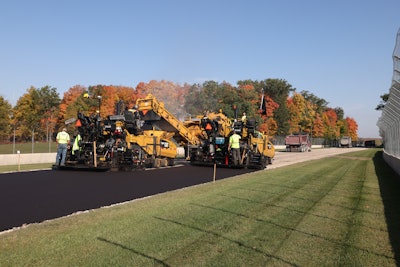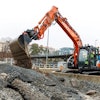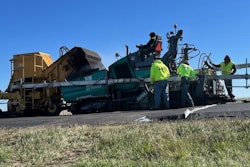
Nestled in the rolling hills of small town Wisconsin lies Road America, a racetrack unlike any other in the world. The 4.048 mile track features 14 turns and sits on 640 acres of land with natural slopes and superelevation changes that thrill racecar drivers and enthusiasts alike. The track hosts dozens of races each year and countless other community events, making it a truly unique - and busy - piece of the racing world.
Last paved in 1995, the Road America course was due for a makeover. The track has deep roots dating back to 1955 however, and the team at Road America, along with fans of the track, didn’t want to see any major changes made to this historic course.
“The initial design was the vision of Clif Tufte. He wanted to evoke the essence of the surrounding roads and how road racing courses were laid out when the sport began. Complete with high speed straights, sweeping turns and several types of elevation,” John Ewert, communications director at Road America says.”
Clif walked the land and staked out the configuration himself. Making sure to not change the existing landscape or topography. What fans see today is the same configuration as in 1955 and we wanted to make sure we didn’t tarnish that history when we made upgrades to the course.”
High-End Prep Work
To ensure racing history was preserved at Road America, discussions and preparations began years before any repaving would begin. Road America wanted to take the opportunity to give the entire facility the upgrades it needed and worked with Northeast Asphalt, a Walbec Group company, to get the extensive project moving.
“Walbec has a long history of success with Road America. Some of the team members who worked on repaving the main track in 1994/1995 are still with the company and worked on the repave in October,” Heather Sayler, project manager at Walbec said. “Walbec has partnered with Road America on their go-carting track, repaving the corners on the Road America track as well as numerous track maintenance projects and other paving contracts on the property. The course repave was one we were all excited about.”
Officials also wanted to take the opportunity with the repave to update the drainage system in eight areas by switching out worn metal culverts with DOT plastic culverts. They also upgraded pitlane infrastructure and updated spectator areas. All work Walbec was able to help facilitate.
“On this extensive project, the Walbec Group was able to provide all the services needed, from managing the quality of the aggregates, asphalt mix, testing, and paving, as well as the engineering for drainage and pipe work installation,” Sayler said. “The team also has experience paving other tracks like the Milwaukee Mile.”
During preparations for this repave, the Walbec team worked to identify and document the uniqueness of the track in 2021. They completed a topographic survey to record and study existing track geometry and placed 18-inch long rebar, 6-inches below the track, to create 25 survey control points.
The entire survey consisted of 7,261 total data points to study the surface of the track and some drainage areas, allowing Walbec to complete massive amounts of prep work before any paving would begin.
Finally, a drone survey was completed to provide high-quality aerial images for further planning purposes. The survey backed up the field work Walbec did while also verifying timing loops and markings along the track.
To prepare the track before paving, Walbec removed 4-inches of old asphalt from the track. Approximately 20,360 tons of asphalt was milled and hauled away from the site.
The entire track was then fine graded to maintain the existing character of the raceway. The motorgraders used robotic technology, along with traditional staking, when completing the grade work. This helped to ensure the edges of the pavement, cross slopes, superelevation transitions and crown lines were all maintained and would stay true to the original track.
“The elevation of the Road America track is unique, and our team worked extremely hard to ensure the existing grades and layout were going to retain those distinctive features of the track,” Sayler said. “We wanted to put everything right back where it was.”
“Fancy” Asphalt
They also wanted to ensure that the work they did would provide years of life for the track, and to do that they needed the right mix and the right processes throughout every step of re-pave.
Like any race track paving project, a lot of research and planning goes into the mix design of the asphalt put down and that started with the rocks. At Road America, the aggregate and asphalt components were sourced from all over the state of Wisconsin.
“This is really fancy asphalt,” Sayler said. “Aggregates were sourced from different locations in the state in order to meet strength requirements for longevity. The mix needs to hold up to the heat and friction of the race cars when they are on it and it needs to survive our winters.”
For a year and a half before paving began, Walbec tested materials. At their locations through Wisconsin, they processed and stockpiled the right aggregates for this mix so they were ready when mix production needed to begin at the end of October 2022.
The 2-½-inch base course installation began on Oct. 10, 2022. Crews put down 12,500 tons of this 19mm mix.
“This was a standard 3 MT 58-28 mix for the lower layer,” Sayler said. “This is a mix you’d see out on the highway, but we are using a beefed up V oil which is a heavy traffic, very firm oil.”
For the surface course design, the Walbec team worked with NASCAR engineers to help determine the best mix and process for installation.
“We came up with a mix that was similar to other road courses, but still designed for this specific location,” Sayler says. “The mix is a 9.5mm virgin mix with 82-28 polymer modified asphalt. We put that down at an inch and a half.”
The crews paved in echelon to avoid any cold center joints and minimize center seam visibility. Approximately 7,890 tons of asphalt was put down on the surface course and multiple tests were performed throughout the project to ensure the surface would handle the weather and racing stresses. The special polymer mix required an agitation tank at the plant which Walbec produced at their Larsen location, 67 miles from Road America.
The work at Road America was amazingly completed in a month’s time from removal of the old surface on Oct. 3, 2022 to the ribbon-cutting ceremony Nov. 3, 2022, commemorating the project’s conclusion. In all, the full project cost to complete the upgrades at Road America will total more than $4 million.
“This is a massive endeavor, and we are extremely excited to have a new racetrack for competitors and fans to enjoy,” Ewert with Road America concludes. “The goal was to keep it the same as our founder Clif Tufte envisioned, and we’re certain we met that goal.”



















